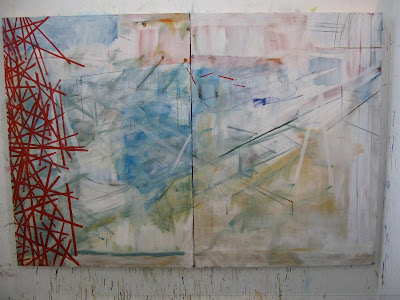 installed - title unknown
installed - title unknown installed - title unknown
installed - title unknown The snowday a few weeks back has out the second years at the Royal College of Art behind on their artist talks. I managed to sit through two of four before deciding to go write about
Robin Footit's work while his talk is still fresh in my mind.
Footit began his talk with a Rene Lalou film,
"How Wang-fo was Saved", introducing the audience to a King raised in complete seclusion, his only contact with the world outside being his father and a large number of scroll paintings, done by the famous artist, Wang-fo. On his 16th birthday, he was released from his prison, only to discover that the real world did not measure up to the one presented in the works of art he had grown up with. He could never come to enjoy this world, and the disappointment it brought to his eyes at every turn. For this he planned to blind the Wang-fo, and cut off his hands, so that he too would exist in a world he could not enjoy.
Footit's work is all about what we see, how we see, and how to make us aware of our visual process. Footit's work typically consists of multiple images arranged in a space. He begins by making images - typically they are a collage of all sorts of things - that find meaning through the relationships found with other works. Self-curation to highlight visual connections usually comes long after a work is completed. Typically multiple works hang on his studio wall for some time before connections are made, or before future works are completed that highlight certain connections. The result completed works are commonly individual works hanging in pairs, situated among a larger installation. Also of concern at this final hanging stage would be how much space is a work given that invites the viewer to occupy the space.
Typical of his working process, not all work are successes, and not all failures are discarded. His attempt to turn a texture into an object is a good example: in the attempt, a bowling ball ended up cast in plaster, but could not be easily removed. The carcass of the experiment, a busted-up cast, still found a place in the work, leaning against the wall, on the floor below the paintings, highlighting a traditional artistic hierarchy of aesthetics and medium.
An example of the sort of visual trickery Footit is interested in is exemplified in the 1965 film by Richard Quinte,
"How to Murder your Wife". There is a scene in this film where the main actor (look at about 2:13 of this clip), Jack Lemmon, is eyeing a dancing girl high on goof-balls, played by Virini Lisi. Behind him is a Caravaggio(esque?) painting of a young boy looking in the same direction, with the very same dreamy looking on its face. These two “looks” highlight many things, such as the Romantic idea of irony, remind the viewer that this is a production, and not real, question who is looking, and who is being looked at. This multiple read is further being expanded by Footit’s reproduction of a reproduction of a reproduction.

possibly titled, "How to Murder Your Wife".
His investigation into visual manipulation has also branched out to include how to influence a viewer's time spent in front of a work. To do this he teamed up with a group of sound artists to create a work consisting of a still image and a four-minute audio component. It is a work that benefits from having this extra time to ponder over it. What the viewer first becomes aware of is the depth of the work, and how that is often cancelled out by the odd shapes and handling of the medium that flatten space back out, reinforcing its actual two-dimensionality. After staring at the work for a couple minutes, it can become evident that there is a geometrical framework that also underlies the work, as illustrated in the sketchbook plan.

"Less Hope", minus the great soundtrack, which is approximately three and a half minutes.
“The Dark eyes of London” is one of Footit’s newer works. In it, he is hoping to create the feeling of looking through the work, as if the surface is a translucent veil that requires visual penetration. This work, in a way, reveals itself over time – a continuation of some of the concerns about duration that Footit has played with in previous works.

"The Dark Eyes of London". Spend some time looking at this work or you'll miss it!
Footit finished the presentation with footage of Wang-fo's escape from the vengeful King. Before subjecting Wang-fo to his punishment, the King kills Wang-fo's loyal aide and commands the artist to finish a scroll painting of a seashore he had left incomplete. While seeing to this task, the sea floods out of the painting and brings Wang-fo, undetected by those all around, into his painting, where he remains undetected by those that cannot really see what is right in front of them.















